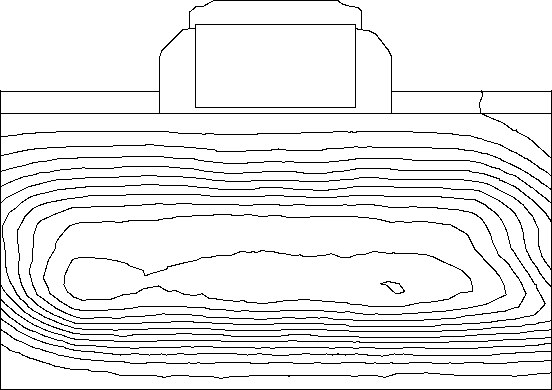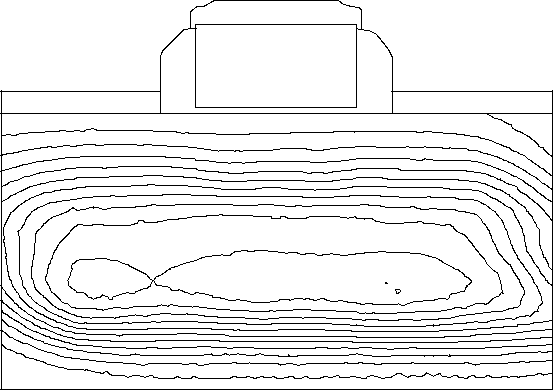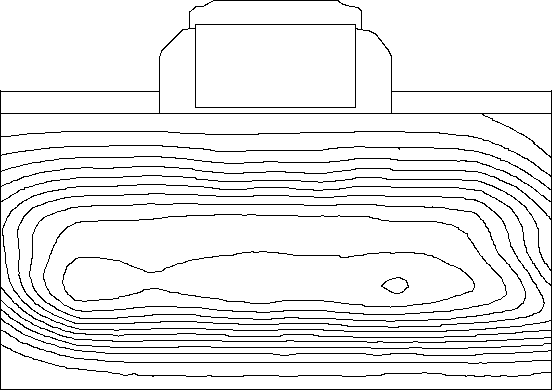





A natural initial approach is to choose the Laplace equation
with the ``internal Dirichlet boundary condition''
for all source grid points  where the attribute value
where the attribute value  is known, and the Neumann boundary condition
is known, and the Neumann boundary condition
for all other (non-Dirichlet) boundary points.
When only boundary values are known and all of
the inner grid points are unknown, the problem is the classical
Dirichlet problem. In our case, however, there are known values
on inner grid points as well.
Let the grid contain  grid points comprised by
grid points comprised by
 unknown and
unknown and  known (Dirichlet) values,
known (Dirichlet) values,  .
The discretization of Equation 6.5 will then lead to
to a system of
.
The discretization of Equation 6.5 will then lead to
to a system of  equations for the unknown
equations for the unknown  .
.
The Delaunay graph and the Voronoi polygons can be readily used
to discretize Equation 6.5. With a finite-difference approximation
and a box integration over the Voronoi regions, one directly obtains
a linear system for the  unknown values
unknown values  . The Neumann boundary
conditions are fulfilled implicitly by the box integration.
The Dirichlet values cause a
non-zero right-hand side of the linear system.
. The Neumann boundary
conditions are fulfilled implicitly by the box integration.
The Dirichlet values cause a
non-zero right-hand side of the linear system.
As Equation 6.5 is generally not fulfilled at the Dirichlet points
(the source grid points), spikes may form at the source grid points where
 originally.
originally.
In Figures 6.29 to 6.32 a comparison of the
Laplace and biharmonic interpolation is presented using a
practical ion-implanted Boron doping profile. Contour lines are
generated using linear interpolation on the respective grid for

The original doping profile (Figure 6.29) has been generated on a dense tensor product grid (the grid is shown in Figure 6.25), then the profile has been interpolated (using a proven two-dimensional cubic spline interpolation [137] [138] on the dense grid) onto the comparatively coarse triangular grid generated by Trigen [113] (the grid is shown in Figure 6.26). The resulting interpolated profile on the Trigen grid is shown in Figure 6.30. This profile has been used as Dirichlet values for the interpolation onto the dense merged triangular grid (Figure 6.27) to evaluate the quality of the interpolation method.

Figure 6.30: Doping profile interpolated onto the coarse
triangular grid.
In this interpolation step from a coarse onto a very fine grid, 21% of the new (merged) grid points are Trigen grid points and define the Dirichlet values, 77% are grid points from the dense tensor product grid, and 2% are inserted by the boundary refinement step. Hence, 79% of the merged grid points are interpolated.
The profile shown in Figure 6.31 was interpolated using the Laplace equation and Figure 6.32 was interpolated using the biharmonic equation. Note the jagged contours and the decay of the peak in Figure 6.31.

Figure 6.31: The solution of the Laplace equation

Figure 6.32: The solution of the biharmonic
equation
Besides the smoother interpolation provided by the biharmonic equation, the peak which is present in the original profile (Figure 6.29), although badly discretized in the coarse Trigen grid, is fairly well reconstructed when the biharmonic equation is used (Figure 6.32). This example shows that the reconstructive biharmonic interpolation method is superior with respect to a straightforward linear interpolation on the coarse triangular grid.




